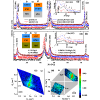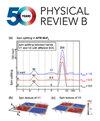Strain-driven exchange interaction and interface magnetism in LaNiO3/La0.67Sr0.33MnO3 heterostructures
IF 3.7
2区 物理与天体物理
Q1 Physics and Astronomy
引用次数: 0
Abstract
The influence of strain and stacking sequence on interfacial ferromagnetism and exchange coupling in correlated oxide (LNO/LSMO) heterostructures is investigated. LNO/LSMO heterostructures are grown on two different substrates [MgO and (STO)] yielding different strains for the oxide layers that lead to different interfacial properties. Polarized neutron reflectivity (PNR) results indicate the emergence of a ferromagnetic interfacial LNO layer and exchange bias for LNO/LSMO heterostructures grown on MgO substrate. In contrast, no such phenomenon was observed for LNO/LSMO heterostructures grown on an STO substrate. Combining magnetometry, PNR, x-ray scattering, and soft x-ray absorption spectroscopy measurements, we found an enhanced magnetic moment and exchange coupling at interfaces that arises from charge transfer and orbital reconstruction via strain engineering in these complex oxide heterostructures. First-principles calculations suggest a possible orbital reconstruction as a result of different strains at interfaces which results from different interfacial magnetic phase behaviors. The study helps understand the manipulation of the exotic states with the aid of strain in oxide-based electronics.

求助全文
约1分钟内获得全文
求助全文
来源期刊

Physical Review B
物理-物理:凝聚态物理
CiteScore
6.70
自引率
32.40%
发文量
0
审稿时长
3.0 months
期刊介绍:
Physical Review B (PRB) is the world’s largest dedicated physics journal, publishing approximately 100 new, high-quality papers each week. The most highly cited journal in condensed matter physics, PRB provides outstanding depth and breadth of coverage, combined with unrivaled context and background for ongoing research by scientists worldwide.
PRB covers the full range of condensed matter, materials physics, and related subfields, including:
-Structure and phase transitions
-Ferroelectrics and multiferroics
-Disordered systems and alloys
-Magnetism
-Superconductivity
-Electronic structure, photonics, and metamaterials
-Semiconductors and mesoscopic systems
-Surfaces, nanoscience, and two-dimensional materials
-Topological states of matter
文献相关原料
| 公司名称 | 产品信息 | 采购帮参考价格 |
|---|
 求助内容:
求助内容: 应助结果提醒方式:
应助结果提醒方式:


